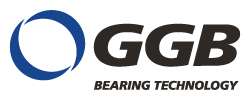GGB Bearing Technology
 | |
| Subsidiary of EnPro Industries, Inc.[1] (NYSE: NPO) | |
| Industry | Manufacturing |
| Founded | 1976 |
| Headquarters | Annecy [2], France |
Number of locations | 8 manufacturing facilities in the U.S., Germany, France, Brazil, Slovakia and China |
Area served | Worldwide |
| Products | Metal-polymer, solid polymer, filament-wound and metallic plain bearings; bushing blocks; bearing housings |
Number of employees | 1,100 |
| Website | www.ggbearings.com www.enproindustries.com |
GGB Bearing Technology, formerly Glacier Garlock Bearings, manufactures self-lubricating and prelubricated plain bearings for various industries and applications. It has production facilities in the U.S., Germany, France, Slovakia, Brazil and China. The company is an EnPro Industries, Inc. company (NYSE: NPO). The company manufactures metal-polymer bearings, engineered plastics bearings, fiber reinforced composite bushings, metal and bimetal bearings, bushing blocks & thrust plates and bearing assemblies.[3]
History
GGB Bearing Technology was formed in 1976 as a joint venture between Garlock Inc., which was established after Olin J. Garlock invented a system for sealing piston rods in industrial steam engines in Palmyra, N.Y. in 1886 [4] or 1887[5], and Glacier Antifriction Metal Company, which had been founded in 1899.[4] Garlock had been the US distributor for Glacier's bearings from 1958.
Glacier developed the industry's first metal-polymer bearing with bronze and polytetrafluoroethylene (PTFE) lining; these DU self-lubricating bushes, launched in 1956, are still being manufactured, specified and used today, and its DX marginally-lubricated bearings, introduced in 1965, are still specified and used for applications where a thin film of lubricant is required.[6]
In 2001 B.F. Goodrich's engineered industrial products division bought Glacier Garlock Bearings.[7] In 2002 this division was spun off as EnPro Industries, Inc.
In 2004 Glacier Garlock Bearings changed its name to GGB Bearing Technology.[8]
In 2012 its DU bearings were used in the sampling drill spindle on NASA's Curiosity Rover on Mars.[9]
Industries
The company's bearings are used by the automotive,[10] aerospace, agriculture, construction, medical,[11] fluid power,[12] compressor, off-highway,[13] recreational equipment, renewable energy,[14] oil & gas, and primary metals production industries.
Present Day Operations
GGB plain bearings are found in a variety of applications worldwide. The DX bearing is used in the Lokomat Pro, a functional robotics system used to improve mobility in individuals following neurological diseases and injuries.[15] Additionally, GGB products can be found in the Gateshead Millennium Bridge (GGB-DBTM monometal maintenance free bearing), the miter gates of the Panama Canal (GGB-DB cast bronze hemispherical bearing), and the Xiangjiaba Hydropower Plant (HPM and HPF fiber reinforced composite bearings).
References
- ↑ "Official 2011 Enpro and GGB Annual Sales Figures".
- ↑ https://www.linkedin.com/company/ggb
- ↑ "Official 2014 Enpro and GGB Annual Sales Figures". Securities and Exchange Commission.
- 1 2 https://www.ggbearings.com/en/company/history-bearing-manufacturer
- ↑ "A Brief History of Palmyra".
- ↑ Austin-Morgan, Tom. "What to Wear?". Eureka. Retrieved 31 March 2016.
- ↑ "BF Goodrich Garlock Division Acquires Glacier Industrial Bearings from Dana Corporation". EBearing News. May 2001.
- ↑ "New Bearing Facility in Slovakia Marks EnPro's Third New Facility Opening in Three Months". The Auto Channel. November 2004.
- ↑ "Bearings from EnPro's GGB Unit Go to Mars". Reuters. Retrieved 31 March 2016.
- ↑ "Bearing All" (PDF). Engine Technology Today. March 2007.
- ↑ "Plain Bearings Shake a Leg". Machine Design. January 2008.
- ↑ "Spherical Bearings Provided for Son La" (PDF). Hydropower & Dams. 2008.
- ↑ "Bearings Go a Step Beyond". OEM Off Highway. February 2007.
- ↑ "GGB's HPMB Bearings Approved for use in Hydropower Turbines". Reuters. Retrieved 31 March 2016.
- ↑ "Bearing Tips". Retrieved 31 March 2016.